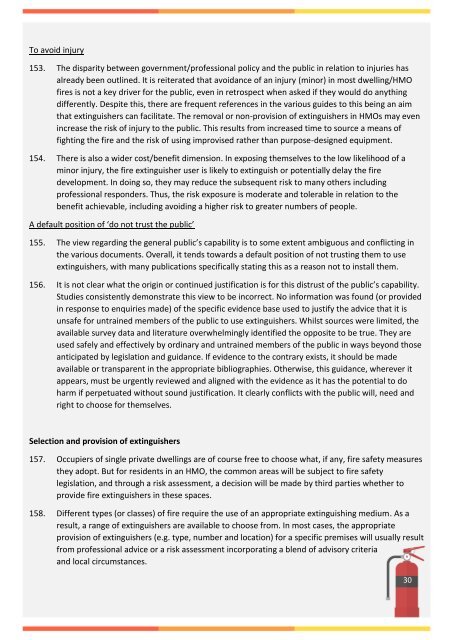An evaluation of the role of fire extinguishers
A report considering the role of a fire extinguisher in human terms identifying the gap between policy assumptions and the evidence from real fires. It considers the implications arising from this and makes a number of recommendations to create an evidence base and enhance current fire safety policies/advice.
A report considering the role of a fire extinguisher in human terms identifying the gap between policy assumptions and the evidence from real fires. It considers the implications arising from this and makes a number of recommendations to create an evidence base and enhance current fire safety policies/advice.
Create successful ePaper yourself
Turn your PDF publications into a flip-book with our unique Google optimized e-Paper software.
To avoid injury<br />
153. The disparity between government/pr<strong>of</strong>essional policy and <strong>the</strong> public in relation to injuries has<br />
already been outlined. It is reiterated that avoidance <strong>of</strong> an injury (minor) in most dwelling/HMO<br />
<strong>fire</strong>s is not a key driver for <strong>the</strong> public, even in retrospect when asked if <strong>the</strong>y would do anything<br />
differently. Despite this, <strong>the</strong>re are frequent references in <strong>the</strong> various guides to this being an aim<br />
that <strong>extinguishers</strong> can facilitate. The removal or non-provision <strong>of</strong> <strong>extinguishers</strong> in HMOs may even<br />
increase <strong>the</strong> risk <strong>of</strong> injury to <strong>the</strong> public. This results from increased time to source a means <strong>of</strong><br />
fighting <strong>the</strong> <strong>fire</strong> and <strong>the</strong> risk <strong>of</strong> using improvised ra<strong>the</strong>r than purpose-designed equipment.<br />
154. There is also a wider cost/benefit dimension. In exposing <strong>the</strong>mselves to <strong>the</strong> low likelihood <strong>of</strong> a<br />
minor injury, <strong>the</strong> <strong>fire</strong> extinguisher user is likely to extinguish or potentially delay <strong>the</strong> <strong>fire</strong><br />
development. In doing so, <strong>the</strong>y may reduce <strong>the</strong> subsequent risk to many o<strong>the</strong>rs including<br />
pr<strong>of</strong>essional responders. Thus, <strong>the</strong> risk exposure is moderate and tolerable in relation to <strong>the</strong><br />
benefit achievable, including avoiding a higher risk to greater numbers <strong>of</strong> people.<br />
A default position <strong>of</strong> ‘do not trust <strong>the</strong> public’<br />
155. The view regarding <strong>the</strong> general public’s capability is to some extent ambiguous and conflicting in<br />
<strong>the</strong> various documents. Overall, it tends towards a default position <strong>of</strong> not trusting <strong>the</strong>m to use<br />
<strong>extinguishers</strong>, with many publications specifically stating this as a reason not to install <strong>the</strong>m.<br />
156. It is not clear what <strong>the</strong> origin or continued justification is for this distrust <strong>of</strong> <strong>the</strong> public’s capability.<br />
Studies consistently demonstrate this view to be incorrect. No information was found (or provided<br />
in response to enquiries made) <strong>of</strong> <strong>the</strong> specific evidence base used to justify <strong>the</strong> advice that it is<br />
unsafe for untrained members <strong>of</strong> <strong>the</strong> public to use <strong>extinguishers</strong>. Whilst sources were limited, <strong>the</strong><br />
available survey data and literature overwhelmingly identified <strong>the</strong> opposite to be true. They are<br />
used safely and effectively by ordinary and untrained members <strong>of</strong> <strong>the</strong> public in ways beyond those<br />
anticipated by legislation and guidance. If evidence to <strong>the</strong> contrary exists, it should be made<br />
available or transparent in <strong>the</strong> appropriate bibliographies. O<strong>the</strong>rwise, this guidance, wherever it<br />
appears, must be urgently reviewed and aligned with <strong>the</strong> evidence as it has <strong>the</strong> potential to do<br />
harm if perpetuated without sound justification. It clearly conflicts with <strong>the</strong> public will, need and<br />
right to choose for <strong>the</strong>mselves.<br />
Selection and provision <strong>of</strong> <strong>extinguishers</strong><br />
157. Occupiers <strong>of</strong> single private dwellings are <strong>of</strong> course free to choose what, if any, <strong>fire</strong> safety measures<br />
<strong>the</strong>y adopt. But for residents in an HMO, <strong>the</strong> common areas will be subject to <strong>fire</strong> safety<br />
legislation, and through a risk assessment, a decision will be made by third parties whe<strong>the</strong>r to<br />
provide <strong>fire</strong> <strong>extinguishers</strong> in <strong>the</strong>se spaces.<br />
158. Different types (or classes) <strong>of</strong> <strong>fire</strong> require <strong>the</strong> use <strong>of</strong> an appropriate extinguishing medium. As a<br />
result, a range <strong>of</strong> <strong>extinguishers</strong> are available to choose from. In most cases, <strong>the</strong> appropriate<br />
provision <strong>of</strong> <strong>extinguishers</strong> (e.g. type, number and location) for a specific premises will usually result<br />
from pr<strong>of</strong>essional advice or a risk assessment incorporating a blend <strong>of</strong> advisory criteria<br />
and local circumstances.<br />
30<br />
28




